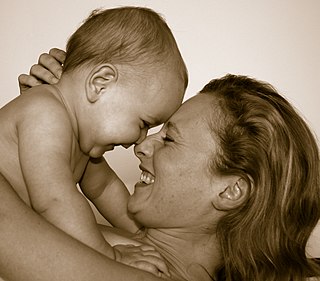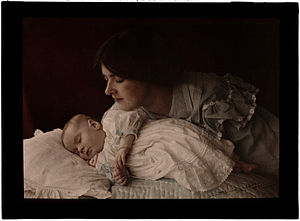Attachment disorder is a broad term intended to describe disorders of mood, behavior, and social relationships arising from unavailability of normal socializing care and attention from primary care giving figures in early childhood. Such a failure would result from unusual early experiences of neglect, abuse, abrupt separation from caregivers between three months and three years of age, frequent change or excessive numbers of caregivers, or lack of caregiver responsiveness to child communicative efforts resulting in a lack of basic trust. A person's attachment style is permanently established before the age of three. A problematic history of social relationships occurring after about age three may be distressing to a child, but does not result in attachment disorder.

Reactive attachment disorder (RAD) is described in clinical literature as a severe and relatively uncommon disorder that can affect children, although these issues do occasionally persist into adulthood. RAD is characterized by markedly disturbed and developmentally inappropriate ways of relating socially in most contexts. It can take the form of a persistent failure to initiate or respond to most social interactions in a developmentally appropriate way—known as the "inhibited form". In the DSM-5, the "disinhibited form" is considered a separate diagnosis named "disinhibited attachment disorder".

Attachment theory is a psychological, evolutionary and ethological theory concerning relationships between humans. The most important tenet is that young children need to develop a relationship with at least one primary caregiver for normal social and emotional development. The theory was formulated by psychiatrist and psychoanalyst John Bowlby.

Edward John Mostyn Bowlby, CBE, FBA, FRCP, FRCPsych was a British psychologist, psychiatrist, and psychoanalyst, notable for his interest in child development and for his pioneering work in attachment theory. A Review of General Psychology survey, published in 2002, ranked Bowlby as the 49th most cited psychologist of the 20th century.
Mary Dinsmore Ainsworth was an American-Canadian developmental psychologist known for her work in the development of the attachment theory. She designed the strange situation procedure to observe early emotional attachment between a child and its primary caregiver.

Attachment in children is "a biological instinct in which proximity to an attachment figure is sought when the child senses or perceives threat or discomfort. Attachment behaviour anticipates a response by the attachment figure which will remove threat or discomfort". Attachment also describes the function of availability, which is the degree to which the authoritative figure is responsive to the child's needs and shares communication with them. Childhood attachment can define characteristics that will shape the child's sense of self, their forms of emotion-regulation, and how they carry out relationships with others. Attachment is found in all mammals to some degree, especially primates.
Attachment measures refer to the various procedures used to assess the attachment system in children and adults. Researchers have developed various ways of assessing self-protective strategies and patterns of attachment. Some methods work across the several models of attachment and some are model-specific.
Co-regulation is a term used in psychology. It is defined most broadly as a "continuous unfolding of individual action that is susceptible to being continuously modified by the continuously changing actions of the partner". An important aspect of this idea is that co-regulation cannot be reduced down to the behaviors or experiences of the individuals involved in the interaction. The interaction is a result of each participant repeatedly regulating the behavior of the other. It is a continuous and dynamic process, rather than the exchange of discrete information.
Cupboard love is a popular learning theory of the 1950s and 1960s based on the research of Sigmund Freud, Anna Freud, Melanie Klein and Mary Ainsworth. Rooted in psychoanalysis, the theory speculates that attachment develops in the early stages of infancy. This process involves the mother satisfying her infant's instinctual needs, exclusively. Cupboard love theorists conclude that during infancy, our primary drive is food which leads to a secondary drive for attachment.

Maternal deprivation is a scientific term summarising the early work of psychiatrist and psychoanalyst John Bowlby on the effects of separating infants and young children from their mother. Although the effect of loss of the mother on the developing child had been considered earlier by Freud and other theorists, Bowlby's work on delinquent and affectionless children and the effects of hospital and institutional care led to his being commissioned to write the World Health Organization's report on the mental health of homeless children in post-war Europe whilst he was head of the Department for Children and Parents at the Tavistock Clinic in London after World War II. The result was the monograph Maternal Care and Mental Health published in 1951, which sets out the maternal deprivation hypothesis.

Attachment theory, originating in the work of John Bowlby, is a psychological, evolutionary and ethological theory that provides a descriptive and explanatory framework for understanding interpersonal relationships between human beings.
Attachment-based therapy applies to interventions or approaches based on attachment theory, originated by John Bowlby. These range from individual therapeutic approaches to public health programs to interventions specifically designed for foster carers. Although attachment theory has become a major scientific theory of socioemotional development with one of the broadest, deepest research lines in modern psychology, attachment theory has, until recently, been less clinically applied than theories with far less empirical support. This may be partly due to lack of attention paid to clinical application by Bowlby himself and partly due to broader meanings of the word 'attachment' used amongst practitioners. It may also be partly due to the mistaken association of attachment theory with the pseudo-scientific interventions misleadingly known as attachment therapy. The approaches set out below are examples of recent clinical applications of attachment theory by mainstream attachment theorists and clinicians and are aimed at infants or children who have developed or are at risk of developing less desirable, insecure attachment styles or an attachment disorder.
The strange situation is a procedure devised by Mary Ainsworth in the 1970s to observe attachment in children, that is relationships between a caregiver and child. It applies to children between the age of nine and 30 months. Broadly speaking, the attachment styles were (1) secure and (2) insecure. Later, Mary Main and her husband Erik Hesse introduced the 3rd category, disorganized. The procedure played an important role in the development of attachment theory.
Mary Main is an American psychologist notable for her work in the field of attachment. A Professor at the University of California Berkeley, Main is particularly known for her introduction of the 'disorganized' infant attachment classification and for development of the Adult Attachment Interview and coding system for assessing states of mind regarding attachment. This work has been described as 'revolutionary' and Main has been described as having 'unprecedented resonance and influence' in the field of psychology.
Patricia McKinsey Crittenden is an American psychologist known for her work in the development of attachment theory and science, her work in the field of developmental psychopathology, and for creation of the Dynamic-Maturational Model of Attachment and Adaptation (DMM).
Separation anxiety disorder (SAD) is an anxiety disorder in which an individual experiences excessive anxiety regarding separation from home and/or from people to whom the individual has a strong emotional attachment. Separation anxiety is a natural part of the developmental process. It is most common in infants and little children, typically between the ages of six to seven months to three years, although it may pathologically manifest itself in older children, adolescents and adults. Unlike SAD, normal separation anxiety indicates healthy advancements in a child's cognitive maturation and should not be considered a developing behavioral problem.
Studies have found that the father is a child's preferred attachment figure in approximately 5–20% of cases. Fathers and mothers may react differently to the same behaviour in an infant, and the infant may react to the parents' behaviour differently depending on which parent performs it.
There are multiple consequences of different attachment patterns that are formed in childhood development. This article will explore the way attachment patterns are formed, how parents pass on their attachment styles, long-term consequences of attachment patterns, and cross cultural attachment patterns.
Internal working model of attachment is a psychological approach that attempts to describe the development of mental representations, specifically the worthiness of the self and expectations of others' reactions to the self. This model is a result of interactions with primary caregivers which become internalized, and is therefore an automatic process. John Bowlby implemented this model in his attachment theory in order to explain how infants act in accordance with these mental representations. It is an important aspect of general attachment theory.
Social emotional development represents a specific domain of child development. It is a gradual, integrative process through which children acquire the capacity to understand, experience, express, and manage emotions and to develop meaningful relationships with others. As such, social emotional development encompasses a large range of skills and constructs, including, but not limited to: self-awareness, joint attention, play, theory of mind, self-esteem, emotion regulation, friendships, and identity development.






